The Sword Book by petrol blue
Live action? Boffers?
Original SA post
Hold onto your boffers, cos shit's about to get
real
... Or, at least,
live action
, and that's near enough the same thing, right?
Live action? Boffers?
Live-Action RolePlay (LARP, or LRP) is where you dress up as characters, then go running around and hitting people with foam weapons ('boffers' in the US). I won't go into more detail here, this is TG, you probably know this already. What nearly all of them have, though, is fighting. And where there's fighting, there's books to tell you how to do it.
And where there's pretend fighting, there's pretentiousness.
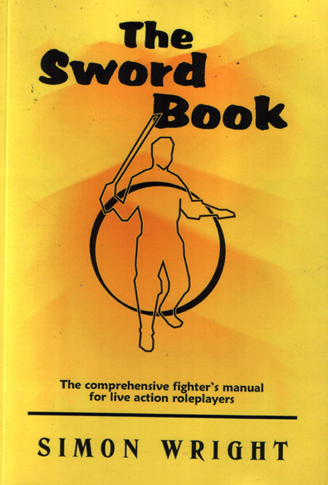
Let me honest here: I don't want to give the impression that I'm good at LARP-fighting. I'm not. The entire reason I have this book is because I'm not. I'm also not good at fighting with real weapons - I did a year or so of viking re-enactment, that's the sum total of my knowledge. I don't want anyone to get the impression that I think I'm better at it than the author, or anyone capable of picking up a sword two times out of three.
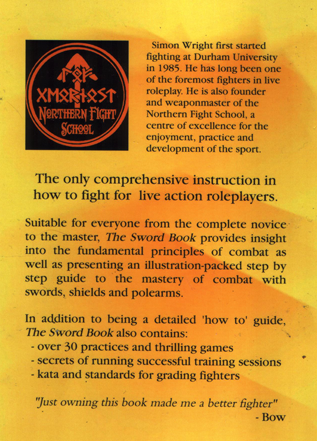
Well, by the end of this thing, I might have to go back and revise that disclaimer. Hell, if just
owning
the book makes me a better fighter, I'm sure to be a modern samurai by the time I'm done.
Our author has clearly had a decent amount of practice, and has started a club just for fighting (as opposed to playing a full LARP). A quick google tells me it's based at Durham University, and runs from 1pm-3pm on sundays, if anyone's in the area. I napkin-mathed that to about 3000 hours of practice if we assume he makes up for missed sessions with actual LARPs, so I figure I can cut him some slack for calling himself 'one of the foremost fighters' - with that much practice, he probably
is
damn good. Enough to kick my arse, anyway. The 'fighter' part I have a bit more issue with, it does imply a certain belief in how serious these foam boffers are, but I can understand using it for the sake of brevity.
As a side note, those runes on the Northern Fight School's logo? They're Tolkein-based, and the best guess I can make at a translation is "leef geeerneest" (that's not a typo with the three 'e's). I think it might be gibberish, but I can't be sure, it might be in elvish or something. Any tolkein-goons have any idea if that sounds like something in one of those languages?
Well, whatever, it's not as important as the contents, right?
 I mean, I'm going to learn over 30 practices and thrilling games. Wait, in a 240 page book, there are 30 practices? Well, I suppose 8 pages each means they can go into lots of detail, fine instruction on technique, that's a lot more reasonable than I'd thought at a glance. Not to mention, I'll learn how to train others, and learn kata... and grading...
I mean, I'm going to learn over 30 practices and thrilling games. Wait, in a 240 page book, there are 30 practices? Well, I suppose 8 pages each means they can go into lots of detail, fine instruction on technique, that's a lot more reasonable than I'd thought at a glance. Not to mention, I'll learn how to train others, and learn kata... and grading...

This book is going to be hella pretentious, isn't it?
The Reason, the Wisdom, and the Reading
These are the three seperate prologue chapters. They're mercifully short, but the names alone give a certain suggestion as to how the book's going to go - Proper Nouns, and lots of them.
The Reason posted:
I hate writing. But sometimes there is no-one to fight. I hope my discomfort with the task will ensure a pleasing brevity to the material.
I decided to write when I found I had forgotten something I once taught. Some would say this is due to me getting older. I would say it is due to the sheer enormity of knowledge I have developed. In this one thing I may not be entirely correct. But I doubt it.
...Oh do fuck right off.
As first words in a book go, those hardly fill me with confidence. Typing it out, I can only assume this was written jokingly, because surely no-one's arrogant enough to write that with a straight face? Right?

If you think I'm being unfair by taking this as a sincere sentiment, the rest of the book reads as a serious (if flowery) instruction book, so it seems a very sudden change of tone if it is one, from a man who describes himself as 'one of the foremost fighters in live roleplay'. Let's not forget that what he means is 'really good at tapping people with foam batons'.
'The Wisdom' tells us that everyone fights differently, to work on our strengths and weaknesses, and to fight lots. Fair enough, can't really argue with that.
'The Reading' simply states that the book doesn't have to be read in order, or equal attention paid to every part. Which I guess would make sense, except I'm a beginner. A total novice. So, shouldn't the book be teaching me how not to impale myself before I work on swinging from chandaliers? As a general rule, most sets of instructions I've seen in my life have a definite start, middle, and end, and screwing with that order really doesn't work out very well.
Terminology
This is where the book really comes to life. You see, Mr. Wright likes giving things names. A lot of these things already have names, but apparently those names aren't good enough for the Northern Fight School. Names like 'arm' and 'leg'. Boring, everyday, non-kung-fu names.
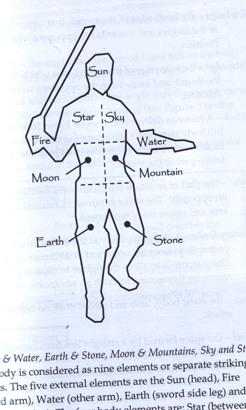
Right-handed? Nope, you're fire-handed .
Imagine, if you will, a trembling neophyte at the school, barely able to hold his foam sword above his beardline. He looks to his new master, who instructs "Strike with your Fire to my Stone!" The student pauses, thinks for a few seconds, and unfolds a bit of notepaper. With a grin of newfound understanding, he solemnly taps the master on the leg with his boffer.
Needless complexity seems to be a trademark here, and as someone hoping to learn from the book, having to decode a simple instruction really isn't going to make my job easier.
A couple more highlights from the glossary include:
Terminology posted:
Dragon Plane: The space a sword passes through during a Dragon Strike.
Tunnel: The space formed by a straight line from between the attacker's right shoulder and any point on the defender. If the attacker points with a straight armand they are pointing at the defender, their arm is in the Tunnel. If they are pointing past the defender, their arm is outside the Tunnel
Don't worry, though, I'm sure it'll all become clearer as we read on.
To be continued..?
I'm aware this book is a bit different to most of the books on here, but it fell into my hands and after about half an hour, I figured the best/only use for it was here. The naming of everything, the self-aggrandisement, the sheer fucking pretension, it demanded a writeup.
Before I write any more, though, I wanted to check the goonmind's reaction: is this too off-topic for a writeup here? Would people like more discussion of larp-fighting in general, or should I stick to dissecting the book? Also, does anyone know any good synonyms for 'pretentious'? I think I'll be needing them.
Hold the non-pointy end
Original SA post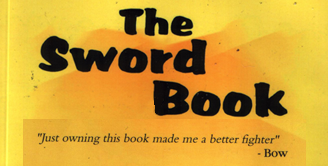
Part 2 - Hold the Non-Pointy end.
After wading through the covers, the forewords, and the terminology, we're finally ready to learn how to hit someone with a foam bat!
The Art of the Single Sword posted:
Before I begin telling you how a fighter should stand and how they should hold their sword, how they should attack or defend and how they should think I would first say that everyone must find their own style within the art. What is set down here is a good form that I have found useful and effective over many years and which I have taught to the people I have practiced with. I see my form in the way they fight, but they do not fight as I do. Take the knowledge written here and then adapt it to suit yourself. Be aware of the Why as much as the How and you will find your own truth. Then test it in combat.
Fighting tests the truth.
This chapter has it's own contents page, just in case you couldn't face flipping back a few pages to the main one. We start with a...
Description of the Sword

Usually up to 42" (which seems the standard for 'one-handed weapon' in larps, I couldn't tell you why - it's not just this book, though), may 'as easily be a mace or a blunt stick'. OK, sure, these aren't real weapons, you don't need to swing them like the real ones, so it doesn't matter if it's a sword or
NO AXES PROLE posted:
Axes, hammers and flails of the same length are more unwieldy and sufficiently different in their application that they merit a seperate treatment. I do not deal with them here as I have yet to find sufficient merit in them to warrant their use over a good sword.
So a mace (big lump of metal on a stick) is more like a sword than an axe (big sharp lump of metal on a stick)? Bear in mind that these 'weapons' are mostly made out of foam, and a five year old could happily swing them. Not that it matters, they're all obviously weapons for the poors who can't afford a katana. Next we move onto ..
Grip
Standard 'hold it like shaking hands' until..
really? posted:
An alternative hold is to grip the handle with a fist. This is a stronger grip and an easier hold to begin with until sufficient finger and forearm strength has been developed to be comfortable in moving to a thumb grip [the book's name for the standard grip]
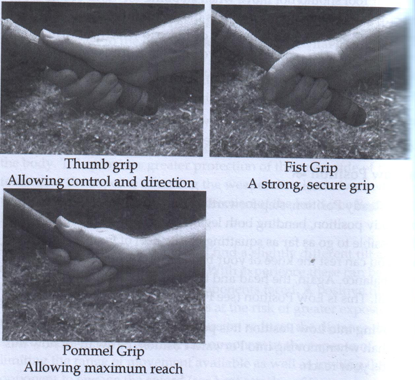
Now, I'm not sure, but that doesn't seem quite right to me. Sounds like a good way to learn a bad habit and then have to unlearn it. Next, we move onto
Stance
Turn a bit sideways, don't cross your legs or stand like you desperately need a slash, and so on. "This is sword position is known as guard position or moon parry." Cool, I'm parrying without even moving, I'm already pretty badass. Plus, I can type words in a sensible order.
There's an interesting part about what to do with your spare arm: in larp-rules, you tend to have hits by location or just total hits - meaning that taking an 'injury' to your arm is often preferable to getting hit in the torso, so the book suggests holding your arm in a 'sling' position (like a broken arm sling) to protect the torso. A pretty decent idea, I think, except you'll look like a complete tit. Other options suggested are 'keep it behind your back to hide it' and 'keep it behind your back for balance' (as in a fencing posture). These options are called (of course they have a Name, don't be stupid) 'the Three Waters'. 'Sling', 'Libran' (the fencing one) and 'Hipster' (behind you and out of the way, though not many people have heard of this one). And finally, we're on to... Nah, just kidding, first we have to
Learn to Parry
why can't I just hit them? posted:
There are three basic parries, Moon parry, Mountain parry, and Sun parry.
But even the first simple parry (ie, 'do nothing') will protect us from "a straight hit such as a Dragon strike" . We might actually have to move to 'a wider position' to defend against "an enveloping strike, such as a Tiger strike" . Glad that's cleared up, then. Now, it's OH FOR FUCKS SAKE I JUST WANT TO...
Advanced parries
Earth, Stone, Star, Sky, Reverse Sun, Back, Moon-on-a-Stick... BACK parry?! Yep, before we've even swung a sword, we're being taught how to step through someone and bring our sword round to defend without looking.
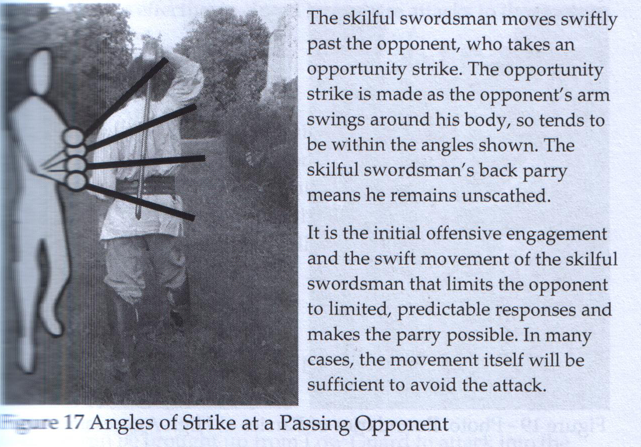
I'm starting to see why we're told to read this book out of order...
Think we're at 'waving our boffer' yet? Bollocks are we. Guards ("don't stand with the sword up your arse"), Movement ("Learn to hammerslide"), I'm just going to skip them because... Well, they're kind of reasonable, honestly, and also I've got massive blue balls about learning how to hit someone. The section on how we should think seems to have gone awol, and while I'm sure it would have been comedy gold, I'm glad because...
Now, finally, finally we're onto poking people with our foam sword...
Woah there bigshot, hold up a goshdarn second... posted:
One thing ourchucklefuckauthor didn't mention in the 'what is a sword' section is anything about larp weapons . In particular, how they're constructed. This is relevant when we get to striking because of one very important difference between larp combat and a real swordfight. That is, you're only meant to gut the neckbeard in front of you like a fish in one of those situations.
Most larp weapons are constructed of a solid core (usually a fibreglass rod) surrounded by stiff foam. All the painting and carving, the making it look kinda-like-a-real-weapon-if-you-squint is just icing on top of that structure. For a clearer idea of how they're made, check out this guide .
Why is this relevant? Because your nice safe boffer has a fibreglass rod inside it. If you were to grip that rod tightly and stab someone with it, it could penetrate that nice soft layer of foam and impale someone for real. This is a Bad Thing, and is why only specially-constructed weapons are allowed to stab, and many systems don't even take a chance with those. Because, let's face it, would you trust a larper who told you their weapon was specially-constructed and extra-safe?
This is why the book doesn't teach you how to stab, although it's not discussed. Safe strikes swing the blade, chopping rather than thrusting, because the rod won't be forced through the foam (and into someone else) that way.
Next time, I swear we actually get to swing our nob-extension.
Did I mention we're 30 Pages into this book? If it seems like I'm going slowly, it's just because your Sun is Willowing my Stone Libram. 1/8th of the way through, and we've not even seen how to swing a weapon. On the other hand, we've learnt advanced parries, so I guess on average, we're doing ok...
So the pointy end goes where?
Original SA post
Part 3 - So the pointy end goes where?
Hell yes, ladies and gents, we're finally here, we're gonna stick some foam right where they don't expect!
page 36 posted:
There are five basic attacks - the Dragon, the Tiger, the Snake, the Rat, and the Bull...
The Dragon is the fundamental form. The Dragon is therefore used to fully explain the range of basic attacks. The Tiger is, I hope, explained fully enough to show the difference from the Dragon yet also the similarity of principles of attack which can be applied across all forms. To avoid excessive repitition, the Snake, Rat and Bull are described only as they differ from the Dragon. The astute reader should not struggle to then apply to these principles of attack described in the Dragon form.
I've checked that quote a few times. I swear I'm not mis-typing. Maybe if I just read it again...
The Dragon posted:
The Dragon is the most basic, most direct and most powerful form of attack. It is the basis of the Northern Fight School teaching.
Right! I'm finally here, learning the most badass ninja skills of the Northern Fight School! Dragon attacks "begin from Ready Position. In a Dragon attack, the shoulder, elbow and wrist all extend together to deliver a blow with the front edge of the blade. The initial arm and sword movement of each strike is straight towards the opponent's head." So, if I'm reading this right, the secret of the Dragon school is to 'twat them with the foam bat'?
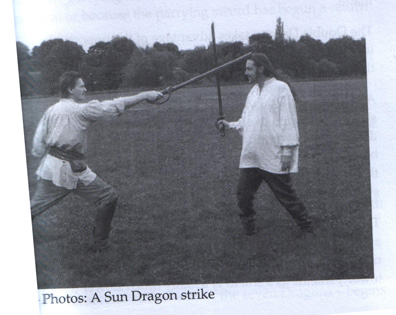
Bet he wishes he'd learnt advanced parries.
But wait, grasshopper! There's more to learn!
Double Dragon posted:
A Double Dragon is an attack consisting of two dragon [tut, tut, no capitalisation in the book] strikes delivered from Forward Position or Low Position, The first strike is always a Sun Dragon [that's a headshot to you and me] which is then followed by any of the Seven Dragons. The second strike can also be a Sun Dragon,
In this section is the Young Dragon (hit them), the Double Dragon (hit them twice), the Full Dragon (hit them twice, then wave the boffer at them while you stagger to your feet), the Broken Dragon (where we start with a feint, as learnt in chapter), and the Slipped Dragon (which is a Broken Dragon with a lisp).
But not one of those can compare to our author's lack of irony when he tells us about...
Chasing the Dragon
Disappointingly, this is just a paragraph about how to use the various
Vanishing Dragon
You many have noticed how I didn't include any juicy pictures of how to perform the dragon strikes or their variants. There's a good reason for that. (Well, there is on my end, I can't speak for the author.) There are three pictures in this whole chapter. One I posted above. The second is exactly the same, but minus the victim. The third shows us the proper angles of attack:
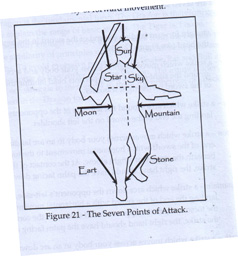
yep, them's some arrows.
So, after, 36 pages of being told how not to accidentally jam a foam bat up your urethra, the entire chapter on basic strikes is 8 pages long, with 3 pictures. That's A5 paper, size 12 print. I want to write more on this, but this review is already a quarter as long as the chapter . So I guess you're just gonna have to wait until next time, when I'll describe...
I'm sorry for the crappy scans, but I'm trying not to fold the book, and my scanner isn't the greatest.
Tigers, Snakes, Rats and Bulls! Oh my!
It might involve hitting them with a foam bat